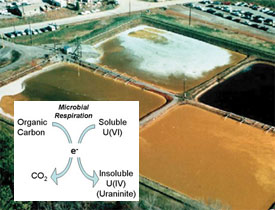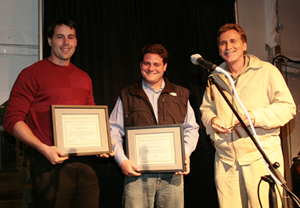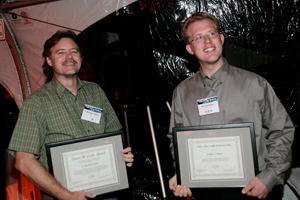
__________________________________________________________________________
SSRL Headlines Vol. 7, No. 4 October, 2006
__________________________________________________________________________
Contents of this Issue:
__________________________________________________________________________
1. Science Highlight —
Uranium-Hungry Bacteria Lead to Safer Water Supply
(contact:
C. Criddle, criddle@stanford.edu)

|
|
Uranium(VI) reduction diagram |
Uranium (U) contamination of ground and surface water is a serious problem in
many parts of the world. Agricultural practices, mining, and nuclear weapons
production have resulted in elevated levels of this heavy metal at a variety of
locations, which threatens human health by seeping into groundwater and
dispersing over large areas. Researchers at Stanford University and Oak Ridge
National Laboratory (ORNL) have now shown that several common types of bacteria
may be used to convert an unstable form of U into a stable form that greatly
reduces the environmental and health threat of contamination.
In groundwater, U is most commonly found in the hexavalent oxidation state,
U(VI)—a highly soluble, mobile and therefore troublesome form. U(VI)
bonds readily with minerals suspended in water and can spread easily over large
areas. However, the tetravalent state, U(IV), resists combining with minerals
and is highly stable and immobile. Several common types of bacteria are known
to convert U(VI) into U(IV), which then precipitates as an insoluble oxide,
uraninite, and researchers have successfully tested a pilot program designed to
exploit this natural process.
Until 1983, millions of gallons of waste containing U and nitric acid were
discharged into unlined ponds at ORNL. Starting in 2001, researchers began
injecting ethanol into the subsurface environment to stimulate microbial
activity, and the results were dramatic—concentrations of U(VI) began
falling rapidly. Research at SSRL using x-ray absorption near-edge structure
(XANES) on SSRL's BL11-2 has verified that those reductions were indeed the
result of stimulated microbial action. Current studies aim to monitor the
long-term stability of biologically reduced U and the viability of
biostimulation as a remediation technique.
To learn more about this research see the full technical highlight at:
http://www-ssrl.slac.stanford.edu/research/highlights_archive/u_remed.html
2. Science Highlight —
Science Highlight - Uranium Trapped in Bacteriogenic Manganese Oxide
Tunnels
(contacts:
J.R. Bargar, bargar@slac.stanford.edu;
S.Webb, samwebb@slac.stanford.edu)
 | |
| Manganese oxides
precipitated around a spore (cell) of the marine Mn(II)-oxidizing bacterium,
Bacillus sp., strain SG-1. | |
Uranium contamination is a major concern at Department of Energy sites and
decommissioned mining and ore processing facilities around the U.S. Migration
of uranium has contaminated ground water in several locations, and the threat
remains for further contamination unless costly measures are taken to isolate
the contaminates and stop their spread. A major obstacle to efficient clean-up
of uranium contamination is the great depth and extensive areas over which they
are dispersed. Subsurface remediation techniques must therefore take advantage
of naturally occurring, environmentally stable agents to stop the spread.
Manganese (Mn) oxides produced by bacteria have been shown to naturally remove
large amounts of heavy metal contaminants from water. These oxides commonly
form coatings on mineral grains within soils and streambeds. Now, researchers
are one step closer to understanding how this process may be harnessed to clean
up uranium contamination. Using two complementary synchrotron-based techniques
(x-ray absorption spectroscopy and in-situ x-ray diffraction),
collaborators from SSRL and Oregon Health and Science University have
characterized how bacteriogenic Mn oxides sequester the highly soluble
hexavalent uranium (U(VI)).
The collaborators found that in high concentrations, as U(VI) is incorporated
into Mn oxides, a stable mineral is formed within which the U(VI) is trapped
inside a three-dimensional matrix of "tunnels." Because the U(VI) is
structurally bound within the bacteriogenic oxides, much larger amounts of
contaminant can be removed from water than with techniques relying on sorption
onto particle surfaces. This research could lead to improved techniques
suitable for long-term stabilization of subsurface U(VI) contamination.
To learn more about this research see the full technical
highlight at:
http://www-ssrl.slac.stanford.edu/research/highlights_archive/mn_biooxides.html
3. Roger Kornberg Wins the 2006 Chemistry Nobel
Prize
L. Cicero
 |
| R. Kornberg |
Roger Kornberg,
professor of Structural
Biology at the Stanford University School of Medicine, is the recipient of the
2006 Nobel Prize in Chemistry for his work in understanding how DNA is
converted into RNA, a process known as transcription. A key step in gene
expression is the transcription of the DNA sequences, comprising the genes,
into a message that can be read by the ribosome to produce proteins.
Transcription is the first step and a key control point in this process, with
RNA polymerase at the heart of the molecular transcription mechanism.
Kornberg's studies have provided an understanding at the atomic level of how
the process of transcription occurs and also how it is controlled. As
transcriptional regulation underlies all aspects of cellular metabolism, his
work also helps explain how the process sometimes goes awry, leading to birth
defects, cancer and other diseases.
Key to this understanding has been the determination of the three-dimensional
arrangement of the atoms in the RNA polymerase - in its "base" structure and
caught in snapshots of it in action - through the use of synchrotron
radiation-based macromolecular crystallography. Kornberg and his group carried
out a significant part of this research at SSRL's macromolecular
crystallography beam lines, starting as early as in 1991 but with the main work
leading to the first published structure in the late 1990s. Some of the results
have been previously highlighted in SSRL Headlines (2001 and again in
2004).
http://www-ssrl.slac.stanford.edu/research/highlights_archive/rna_polymerase.pdf
http://www-ssrl.slac.stanford.edu/research/highlights_archive/rna_polymerase_04.pdf
The SSRL Structural Molecular Biology Program and the beam lines on which much
of the crystallography work was performed are supported by the Department of
Energy, Office of Biological and Environmental Research and by the National
Institutes of Health, National Center for Research Resources and National
Institutes of General Medical Sciences. SSRL operations are supported by the
Department of Energy, Office of Basic Energy Science. Read the full press
release from the Royal Swedish Academy of Sciences.
http://nobelprize.org/nobel_prizes/chemistry/laureates/2006/press.html
4. Another Successful Users' Meeting
(SSRL33 Co-Chairs:
C. Kim, cskim@chapman.edu;
A.
Lindenberg, aaronl@slac.stanford.edu)
SSRL33 featured excellent science, friendly camaraderie, delicious
refreshments, and entertainment. Approximately 300 people participated in this
33rd Annual SSRL Users' Meeting, with workshops and social events October
11-13, 2006. In the opening session, SLAC Deputy Director Keith Hodgson
welcomed users and gave introductory remarks. Jo Stöhr, SSRL Director, gave an
update on current and future plans for SPEAR3 as well as an update on plans for
500 mA and top-off injection tests during the 2007 run. SSRLUOEC Chair Joy
Andrews discussed recent activities of the SSRL Users' Organization, including
coordinated activities with representatives from other DOE facilities. Pedro
Montano, Director of Scientific User Facilities, DOE Office of Basic Energy
Sciences, gave an update from the perspective of the DOE Office of Science. In
a special keynote presentation, Z.X. Shen gave a presentation reflecting on the
contributions of Bill Oosterhuis: A Legacy and Vision for the Future.
D. Rogers
 | |
| from left: D. Fritz, A.
Cavalieri and J. Stöhr | |
The scientific sessions of SSRL33 focused on user scientific highlights over
the past year, new opportunities for microfocusing and high resolution imaging,
structural biology, ultrafast science and new scientific opportunities for
SPEAR3. During the young investigators session, recipients of the W. E. Spicer
Award, Adrian Cavalieri (Max Planck Institute of Quantum Optics) and David
Fritz (SSRL), gave presentations on their respective projects: Clocking
Femtosecond X-rays (A. Cavalieri) and Mapping the Excited State Potential
Energy Surface of Bismuth (D. Fritz).
http://today.slac.stanford.edu/a/2006/10-09.htm
Over 50 users presented their research activities during the poster session on
October 12, and prizes were awarded to four students for their outstanding
posters:
| | |
Christopher Lentini (Chapman University), Sorption and Structural
Incorporation of Hg(II) and Zn(II) onto Nanoscale Iron Oxyhydroxides
Wei-Sheng Lee (Stanford University), Is One Mode Enough? The Existence of
Multiple Bosonic Modes Coupling in
Bi2Sr2CaCu2O8
Alexandra Zidovska (UC Santa Barbara), A Two-Dimensional Columnar
Phase of
Cationic Liposome-DNA Complexes for Gene Delivery: Hexagonally Ordered
Cylindrical Micelles Embedded within a DNA Honeycomb Lattice
Cori Demmelmaier (UC Santa Barbara), XAS Investigation of the
Precursor to the Phillips Catalyst
| |
D. Rogers
 Poster award winners from left:C. Lentini, W.-S. Lee, A. Zidovska, C.
Demmelmaier
Poster award winners from left:C. Lentini, W.-S. Lee, A. Zidovska, C.
Demmelmaier |
|
Several joint SSRL/ALS workshops were held to give users the opportunity to
explore techniques in more depth and, in some cases, to gain hands-on
experience and training in using beam line equipment and software.
http://www-conf.slac.stanford.edu/ssrl/2006/workshops.htm
Overall, SSRL33 was a great success, and we look forward to SSRL34 - Mark your
calendars now and plan to attend the 34th Annual SSRL Users' Meeting and
Workshops on October 1-3, 2007!
5. SSRL Awards Honor Mike Soltis and Bill
Schlotter
—J. Yauck,
SLAC Today
Congratulations to scientist Mike Soltis and graduate student Bill Schlotter,
recipients of the Farrel W. Lytle Award and the Melvin P. Klein Scientific
Development Award, respectively. The two awards were presented at the 33rd
Annual Stanford Synchrotron Radiation Laboratory (SSRL) Users' Meeting on
October 12.
D. Rogers
 |
|
M. Soltis and B. Schlotter |
The Lytle Award, given annually since 1998, recognizes technical or scientific
achievements in synchrotron radiation-based science as well as efforts to
promote collaboration and efficiency at SSRL. Soltis received the honor for his
leadership in developing and implementing advanced robotics and remote-access
systems at SSRL's crystallography beam lines, and for developing many
now-common techniques for cryo-cooling of crystals. Soltis, who has led the
SSRL Macromolecular Crystallography Group since 1999, was also recognized for
his role in establishing a world-renowned user-support program at SSRL. "Mike
Soltis represents perfectly what the Lytle Award represents," says Linda
Brinen, a structural biologist on the faculty at UC-San Francisco and an SSRL
user. "His dedication to making top-notch science succeed is constant, as is
his unfailing ability to work with both staff and users. He is a true
professional."
The Klein Award, presented for the first time this year, recognizes outstanding
scientific work performed at SSRL by a graduate or undergraduate student. Bill
Schlotter received the award for conceiving and developing a technique that
improves the quality of x-ray microscopy images without using longer exposure
times or higher illumination intensities, which can damage samples. The
technique averages multiple holographic reference images of a sample, taken
simultaneously and at relatively low x-ray intensities, into a single final
image. According to Jo Stöhr, SSRL Director and Schlotter's research advisor,
the technique will have applications in research performed at the future Linac
Coherent Light Source, the world's first x-ray laser. "I believe Mel Klein, who
I knew quite well and for whom the award is named, would have liked Bill's
clever idea and its implementation," he says.
http://today.slac.stanford.edu/a/2006/10-13.htm
6. SSRL Users' Organization Executive Committee
Update
(2007 SSRLUOEC Chair: C. Kim, SSRLUOEC Vice-Chair, cskim@chapman.edu;
2006 SSRLUOEC
Chair: J. Andrews, SSRLUOEC Chair,
joy.andrews@csueastbay.edu)
D. Rogers
 | |
C. Kim
2007
SSRLUOEC Chair | |
|
At
the October 13 SSRL Users' Organization Executive Committee (SSRLUOEC) meeting
we welcomed the five newly elected user representatives: Wayne Lukens (LBNL),
Art Nelson (LLNL), Karen McFarlane Holman (Willamette University), Monika
Sommerhalter (Cal State East Bay) and Becky Fenn (Stanford University, graduate
student). Jo Stöhr led a discussion encouraging users to provide input on their
thoughts regarding the future of SSRL so that it can be folded into planning
efforts. In addition to working with SSRL management to determine priorities
and strategies, the SSRLUOEC also participates in meetings of the SLAC and SSRL
advisory panels and coordinates activities with representatives from other DOE
user facilities to promote and sustain support for basic sciences. User input
is vital, and we urge you to become more engaged in these activities or to
contact us to share your views so that we can best represent the interests of
the entire SSRL user community.
http://www-ssrl.slac.stanford.edu/users/ssrluo/ssrluoec-fy07.html
7. Ground Breaking New Science
—B. Plummer and R. Courtland SLAC Today
D. Rogers
 | |
|
from left: J. Dorfan, J. Etchemendy, R. Orbach, A. Eshoo and Z. Lofgren
| |
On Friday, October 20, SLAC officially
broke ground for the Linac Coherent
Light Source (LCLS), the world's first x-ray free-electron laser. Scheduled for
completion in 2009, the LCLS will produce ultra-fast, ultra-short pulses of
x-rays a billion times brighter than any other source on earth. The LCLS "will
drive understanding and opportunity as no facility has ever done before," said
DOE Under Secretary of Science Raymond L. Orbach, who delivered the keynote
address during the ceremony. "What you'll have here is what we all hope for, a
window into the future, one that we think we will understand, but where
conventional wisdom can be turned on its head."
Nearly 1,000 attendees looked on as Orbach and other dignitaries including
Congresswomen Anna Eshoo and Zoe Lofgren, Congressman Mike Honda, Stanford
University Provost John Etchemendy, and SLAC Director Jonathan Dorfan
ceremonially shoveled the first spades of earth at the start of the event. The
audience then cheered as an excavator scooped the first bucket of dirt from the
site of the LCLS Near Experimental Hall. Read more...
http://home.slac.stanford.edu/pressreleases/2006/20061020.htm
8. NIH-NCRR Officials Visit SSRL
(contacts:
K.O. Hodgson, hodgson@slac.stanford.edu;
B. Hedman, hedman@ssrl.slac.stanford.edu)
Drs. Barbara Alving, Acting Director, and Amy Swain, Health Sciences
Administrator of the National Institutes of Health National Center for Research
Resources (NIH-NCRR), visited Stanford and SLAC on Tuesday, October 10. After
spending the morning at the Stanford Medical School the agenda for the
afternoon was focused on the NCRR Synchrotron Radiation Structural Biology
Resource program at SSRL.
Keith Hodgson and Britt Hedman led a tour of the SSRL experimental hall and the
SPEAR3 ring, stopping at several structural biology beam lines where users and
staff gave brief presentations on the beam line facilities and the research
they conduct there. Our thanks to David Bushnell (Stanford), Sarah Hymowitz
(Genentech), Kelly Lee (Scripps), Martina Ralle (OHSU), Vittal Yachandra (LBNL)
and Alexandra Zidovska (UC Santa Barbara) for their time and effort in helping
put together a successful demonstration of the research enabled by the NIH
NCRR's continued support of SSRL's structural molecular biology program.
9.
SESAME to Open: Particle Accelerator Spurs Middle East Science Partnership
—Clara
Moskowitz, Stanford Report
|
 |
|
H.
Winick |
When Stanford physicist Herman Winick heard that Germany was planning to throw
out an old particle accelerator, he thought, why not donate it to the Middle
East? This idea has sparked plans to build a new state-of-the-art research
facility in Jordan using pieces of the old German equipment. The lab will speed
up electrons in a circle to produce high-energy light called synchrotron
radiation, which is useful for a host of experiments. The project's leaders
hope that the new facility will help solve important scientific questions and
bring together researchers from different parts of the region.
"My main motivation is to help create a project in which people can work
constructively and collectively," Winick said. "There will be collaborations
between Israeli and Arab scientists, in particular. This is reasonably
unusual." Previous cooperation has been bilateral (between just Israel and
Palestine, for example). This is the first time that scientists from many
different Arab nations, along with Israel, will all work together, he
explained. Read more in the Stanford Report...
http://news-service.stanford.edu/news/2006/october25/sesame-102506.html
10.
Beam Time Request for X-ray/VUV and Macromolecular Crystallography
Proposals Due December 1
(contacts:
C. Knotts, knotts@slac.stanford.edu;
L. Dunn, lisa@slac.stanford.edu)
The SPEAR operating schedule and user schedule by beam line for the first
scheduling period (which begins this week) is posted on the web
http://www-ssrl.slac.stanford.edu/schedules/
X-ray/VUV Beam time requests for the second scheduling period in 2007
(Feb-May) need to be submitted by Friday, December 1:
http://www-ssrl.slac.stanford.edu/users/user_admin/xray_btrf.html
http://www-ssrl.slac.stanford.edu/users/user_admin/vuv_btrf.html
The next proposal deadline for macromolecular crystallography proposals is also
December 1. Proposals submitted for this deadline will be eligible for beam
time beginning in March 2007. Spokespersons with expiring proposals will be
reminded via direct email in early November.
http://smb.slac.stanford.edu/
http://www-ssrl.slac.stanford.edu/users/user_admin/px_proposal_guide.html
11.
Photon Science Job Opportunities
A number of positions are currently available at the LCLS, LUSI and SSRL.
Please refer to the Photon Science Job Openings page for more information about
these job opportunities.
http://www-ssrl.slac.stanford.edu/photonscience/jobs.html
__________________________________________________________________________
SSRL Headlines is published electronically monthly to inform SSRL users,
sponsors and other interested people about happenings at SSRL. SSRL is a
national synchrotron user facility operated by Stanford University for the
U.S. Department of Energy Office of Basic Energy
Sciences. Additional support for
the structural biology program is provided by
the DOE
Office of Biological and Environmental Research, the NIH
National Center for Research Resources and the NIH Institute for General Medical
Sciences. Additional information about
SSRL and its operation and schedules is available from the SSRL WWW
site.
__________________________________________________________________________
To leave the SSRL-HEADLINES distribution, send email as shown below:
To: LISTSERV@SSRL.SLAC.STANFORD.EDU
Subject: (blank, or anything you like)
The message body should read
SIGNOFF SSRL-HEADLINES
That's all it takes. (If we have an old email address for you that is
forwarded to your current address, the system may not recognize who
should be unsubscribed. In that case please write to
ssrl-headlines-request@ssrl.slac.stanford.edu and we'll try to figure out
who you are so that you can be unsubscribed.)
If a colleague would like to subscribe to the list, he or she should send
To: LISTSERV@SSRL.SLAC.STANFORD.EDU and use the message body
SUBSCRIBE SSRL-HEADLINES






 Poster award winners from left:C. Lentini, W.-S. Lee, A. Zidovska, C.
Demmelmaier
Poster award winners from left:C. Lentini, W.-S. Lee, A. Zidovska, C.
Demmelmaier


